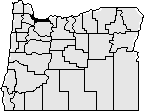
Multnomah County was created Dec. 22, 1854. It was the 13th county created in Oregon Territory. The land was taken from the eastern portion of Washington County and the northern part of Clackamas County. The borders have remained relatively unchanged to the present.
Multnomah County was created when the people living in Portland found it difficult to travel to Hillsboro to conduct business at the county seat of Washington County. They also thought they were paying too much in taxes to support the farmers in the rural areas surrounding Portland. In 1854, Portland businessmen petitioned the Territorial Legislature for a new county and Multnomah County was created at the subsequent session. The county was named after the Multnomah Indians who were part of the Chinookan tribe that lived on the eastern tip of what is now Sauvie Island in the Columbia River. The City of Portland was chartered in 1851 and made the county seat in 1854. The Multnomah County Commissioners met for the first time on Jan. 17, 1855.
Multnomah County is the smallest county in Oregon, with only 465 square miles. It is bounded by Columbia County and the Columbia River on the north, Washington County on the west, Clackamas County on the south, and Hood River County on the east. Multnomah County is very diverse with Portland in the west and the Columbia Gorge and Mt. Hood in the east. Most of the eastern portion of the county is covered with timber and is sparsely populated.
The first courthouse was built in 1866. Expanding county business required the addition of a north wing in 1885 and a south wing in 1889. In 1914 a new courthouse was completed at the same location.
The voters of Multnomah County approved a home rule charter on May 24, 1966, which became effective Jan. 1, 1967. The primary organizational change was a governing body consisting of a board of 5 full-time county commissioners, which is the policy determining body of the county. In 1968 the board of commissioners established administrative departments to operate county services and administer county affairs. The commissioners change the organization and duties of departments to meet changing needs. The county commissioners, auditor, sheriff, and district attorney are elected officials.
The principle industries of Multnomah County are manufacturing, transportation, wholesale and retail trade, and tourism. Tourism attractions include the Oregon Museum of Science and Industry, Washington Park and Zoo, Oregon Historical Society, Portland Art Museum, Rose Test Gardens, and Japanese Garden in Portland, and Multnomah Falls in the Columbia River Gorge. The Port of Portland, established in 1891, exports more wheat from its marine terminals than any American port. The port also ranks high in overall tonnage and the importation of automobiles.
The population of Multnomah County has steadily increased since 1860. The 2009 county population of 724,680 represented an increase of 9.7% over 2000. Portland is the county's largest city with a 2009 population of 582,130.